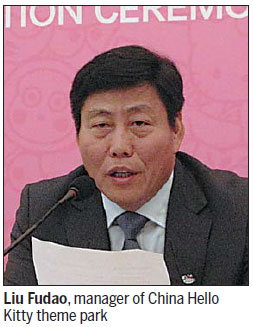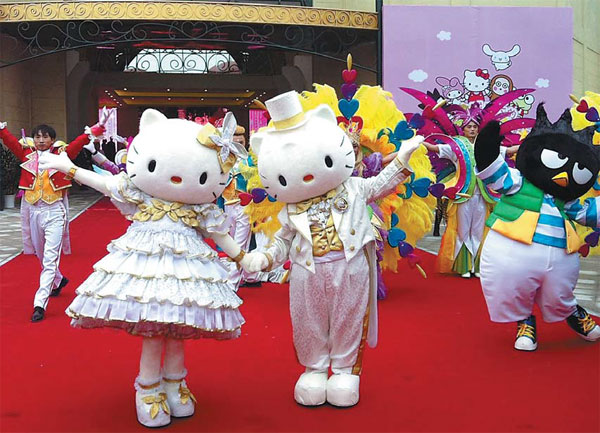In cat and mouse game, Kitty jumps into lead
Updated: 2015-02-06 07:40
By Liu Lu(China Daily Europe)
|
|||||||||||
Japanese cartoon character brings her sweet charm to China
There is a new cat on the block in China, and she promises to give a certain mouse a run for his money.
Hello Kitty, the Japanese-born cartoon character adored by millions, has had a theme park built in her honor in Zhejiang province, and its owners are looking for the kind of success that Mickey Mouse has helped Disney theme parks enjoy worldwide.
|
China Hello Kitty theme park opened in the county of Anji in Zhejiang province last month. Photos by Liu Lu / China Daily |
The park opened last month in Anji, a county known for its bamboo forests, canyons, gardens and waterfalls, and is near Shanghai and about three hours by car from Shanghai Pudong International Airport.
With investment estimated at $215 million, the park has mountains as its backdrop and is the third, and biggest, Hello Kitty theme park in the world. The others, Puroland and Harmonyland, are in Japan and attract millions of people each year.
The 60 hectare complex is an international collaboration between Japanese firm Sanrio, which created Hello Kitty in 1974; Shanghai Insight Holding Group Co, a Chinese property company; and California-based theme park design firm The Hettema Group.
"Hello Kitty has been a worldwide phenomenon for decades, and the character is very popular in China," says Tsuji Yuko, chief executive officer of Sanrio.
"That's why we chose to build the first overseas park in China. We hope to provide a place that can allow people to have intimate contact with Hello Kitty and hope to develop the Chinese theme park market."
A million visitors are expected each year, says Liu Fudao, manager of China Hello Kitty theme park. Hello Kitty, a character oozing Japanese-style sweet charm, has been given the mission of turning the venue into "the cutest theme park on Earth", and it will be targeted at families with preteen children and young women who collect merchandise bearing the likeness of the white bobtail cat with the red bow, Liu says.
There have been worries about the challenge Hello Kitty will face when the Shanghai Disney Resort, now being built, opens next year, but Liu says he is confident the Anji park will replicate the success of the parks in Japan.

"Through differentiated positioning, Hello Kitty Park has no reason to worry about fierce competition in a region that is a hot spot for both international and domestic theme park investors."
In fact, Liu says Anji was chosen as the venue because of its proximity to Shanghai and a significant growth in tourism in Zhejiang and its neighboring provinces in the past few years.
"Anji is in China's most economically developed region, the Yangtze River Delta, and people here have higher disposable incomes and are more willing to travel, so we reckon we can attract many locals. At the same time, the good transport here will help us attract tourists from all over the country."
Hello Kitty Park is both a festive playland and a natural park where children can learn about the environment through imaginative, hands-on activities, he says.
The park grounds are divided into six zones, each featuring more than 10 visitor attractions, such as Hello Kitty-themed rides, shows and parades, and featuring a decorated Ferris wheel, along with movies, shops and catering services.
"Unlike in the US, where they focus on thrill rides, Chinese park-goers prefer extravagant shows with casts of hundreds," Liu says, adding that there are interactive and walk-through activities that will follow the popular Hello Kitty theme.
The park differs greatly from Puroland and Harmonyland, having Chinese characteristics. Each of the five natural elements in Chinese philosophy - wood, fire, water, metal and earth - are represented in five garden zones, each with a designated area in the park and each designed to bring to life the Hello Kitty theme.
A world festival area will feature Chinese holiday and cultural celebrations such as the lunar New Year.
"The great fusion of Chinese cultural elements in this park is unique," Liu says.
Making good use of Chinese culture is critical for as the park as it looks to entice local tourists, he says.
During the week, admission for adults will cost the equivalent of $42 (37 euros) and for children $32; on the weekend, admission for adults will cost $52 and children $42.
The new Hello Kitty park is just part of the attraction. There will also be a luxury resort hotel fitted with pink furniture, chandeliers and lots of bows. There will also be a Hello Kitty themed mahjong room. The hotel is expected to offer stiff competition to the Shanghai Disney Resort's Toy Story-themed hotel, both having a strong touch of their popular cartoon figures.
Industry analysts say people born in the 1980s in China will become the main patrons of these theme parks featuring cartoon characters, because they are more likely to take their children to them.
"From 2010 to 2020, woman aged from 20 to 29 will gradually create a baby boom," says Kelvin Chen, executive director of Ipsos in China, a global market research company. "At the same time, as the country further relaxes the one-child policy by allowing families to have two children, China's children's consumer market is expected to further expand."
Mickey Mouse, Hello Kitty and Lego bricks will become more prevalent in China in the coming years as the disposable incomes of the region's newly affluent fuel a boom in theme park construction.
Chen says the industry expansion comes at the right time for theme park builders and investors because attendance is dwindling in Europe and the United States. The entry of international theme park brands presents a good chance for China's domestic operators to learn from their successful operations worldwide, he says.
"China's domestic theme park investors are in a frenzied period of investment, but their operating results are disappointing because only 10 percent of them are making money, and even fewer are able to compete with the world-renowned amusement park brands," Chen says.
But he believes it is possible for home-grown theme parks to compete with international big names. Ocean Park in Hong Kong, which features a vast aquarium and roller coaster rides all perched atop one of Hong Kong's lush craggy peaks, has enjoyed rising attendance figures despite the threat from Disney.
"Domestic parks can win a strong foothold in this more and more competitive market as long as they continue to invest in brand building and establish their own cultural characteristics," Chen says.
(China Daily European Weekly 02/06/2015 page15)
Today's Top News
Chinese FM eyes 'harvest' for ties with Slovakia
Russia leads UN initiative to target IS
New Greek govt lobbies across Europe for solution to its debt
Birmingham plans to transform city into global financial hub
China: Norway violates rights of Chinese scholar
Italy extradites suspect in theft
A great future for UK-China business relationship
Former IMF chief Strauss-Kahn on trial over pimping charges
Hot Topics
Lunar probe , China growth forecasts, Emission rules get tougher, China seen through 'colored lens', International board,
Editor's Picks

|

|

|

|

|

|






